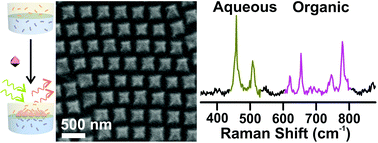Assembling substrate-less plasmonic metacrystals at the oil/water interface for multiplex ultratrace analyte detection†
Abstract
Current substrate-less SERS platforms are limited to uncontrolled aggregation of plasmonic nanoparticles or quasi-crystalline arrays of spherical nanoparticles, with no study on how the lattice structures formed by nanoparticle self-assembly affect their detection capabilities. Here, we organize Ag octahedral building blocks into two large-area plasmonic metacrystals at the oil/water interface, and investigate their in situ SERS sensing capabilities. Amphiphilic octahedra assemble into a hexagonal close-packed metacrystal, while hydrophobic octahedra assemble into an open square metacrystal. The lower packing density square metacrystal gives rise to much stronger SERS enhancement than the denser packing hexagonal metacrystal, arising from the larger areas of plasmonic hotspots within the square metacrystal at the excitation wavelength. We further demonstrate the ability of the square metacrystal to achieve quantitative ultratrace detection of analytes from both the aqueous and organic phases. Detection limits are at the nano-molar levels, with analytical enhancement factors reaching 108. In addition, multiplex detection across both phases can be achieved in situ without any loss of signal quantitation.

- This article is part of the themed collection: Surface-enhanced Raman scattering

 Please wait while we load your content...
Please wait while we load your content...